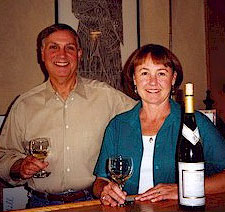The California Central Coast is home to many premium wine makers. Though less renowned than their Napa and Sonoma neighbors, Central Coast wine producers are consistently turning out great niche wines and marketing them to a rapidly growing base of Central Coast oenophiles. Based about 150 miles north of Santa Barbara in San Luis Obispo, Claiborne & Churchill is a fine example of a premium Central Coast winery. IntoWine.com recently caught up with Claiborne Thompson (one half the namesake behind "Claiborne & Churchill) to discuss his winery's focused niche of "Alsatian Style" wines, the current Riesling "craze", and his transformation from academia to winemaker.
Why did you choose to focus on fruity but dry "Alsace derived" wines?
We chose "Alsatian style" wines for three reasons: (a) to be completely different from the wines of our host winery (Edna Valley Vineyard), where I was working and who allowed us to start our winemaking in their cellar, (b) because we thought it would be a great unoccupied niche and if the wines were dry instead of sweet people would start drinking them more, and (c) both Fredericka and I love Alsace and its wines and have been there frequently.

They are a little fruitier and not as earthy. Also they do not have any of the oily or bitter qualities you sometimes find in Alsace. Our acids are also a little lower.
In the early 80's you made a career change from being a Professor of Old Norse Languages at the University of Michigan to being a California winemaker. How did you go about learning the new profession?
On an (academic) trip to California in 1981, I visited a few wineries and got "bit by the wine bug." I talked my way into a job as a "cellar rat" at Edna Valley Vineyard, went back to Michigan, got (re-)married, sold my house and moved to California. I was Edna Valley's third employee. I worked there for five years, and they let me learn every aspect of the business. (It was much less structured and corporate than now.)
Why did you choose San Luis Obispo as home base over the perhaps more obvious and sexy wine locales of Napa or Sonoma?
We moved to SLO because of my employment at Edna Valley.
Since your first crush in 1983, how have your grape purchasing options changed? As time passes are you finding more and better grapes or is it becoming more difficult?
In the beginning (1983-1987) we purchased Riesling and Gewurztraminer from Paragon Vineyard, just down the road (and a partner in Edna Valley Vineyard). In 1988 they grafted these varieties over to Chardonnay, so we found sources in Santa Barbara and Monterey Counties. We stick mostly to Monterey County fruit now, buying from the same vineyard for almost twenty years. There is always a danger that these grapes may end up in short supply, but I believe the growers know how important their grapes are to us, and what good wine we make from them (which in turn makes them look good).
In almost 25 years of producing wines, which is your finest vintage?
There have been a number of memorable vintages. The 1986 Riesling was a great one, the 1991 Gewurztraminer also. (Of course, as we all know, the best vintage is the one I'm trying to sell now!)
California Riesling is getting a lot of press lately for returning to prominence after having fallen out of favor for many years. Which years were the roughest and what went through your mind as you "stuck with Riesling" during those tough times?
I'm not sure how serious we should take all of this talk about a "Riesling Renaissance" and it being "the next hot wine" etc etc. Hey, but wine writers have to say something new, don't they? Our business has grown steadily as people find our about us and try our wines and discover the pleasures of drinking dry but fruity wines. We haven't seen huge up-ticks in our sales of our "Alsatian" varieties from anything in the media. (Pinot Noir is of course a different story.)
The roughest time for us were times of economic recession (e.g. 1989-91), when people were not spending money on luxuries, and before we were established and well-know enough to survive a recession. But we were too stubborn to give up.
Conversely, what are you experiencing now that Riesling is in vogue that perhaps was unheard of during the down years?
We sell everything we make, but it's hard to say whether it's because we're "in vogue" or just finally being recognized for quality and good value.
What inspired this shift in consumer thinking towards Riesling? Was there a "Sideways" moment or series of events that signaled the change in perspective?
I don't know of any one thing that accounts for consumers' more accepting attitude towards Riesling. Probably a combination of factors. Growing boredom with Chardonnay, larger wine-drinking demographic (including drinkers who never learned that it wasn't "cool" to drink Riesling), better examples of California Rieslings.
Speaking of "Sideways", as someone who endured a down period, any advice for makers of Merlot?
It's inevitable that when a wine gets "hot" like Merlot, it's sowing the seeds of its own destruction, because with the proliferation of Merlot bottlings (to take advantage of the trend) there will always be more and more lousy or mediocre ones, which in turn kills the goose that lays the golden egg. Pardon the mixing of metaphors!

